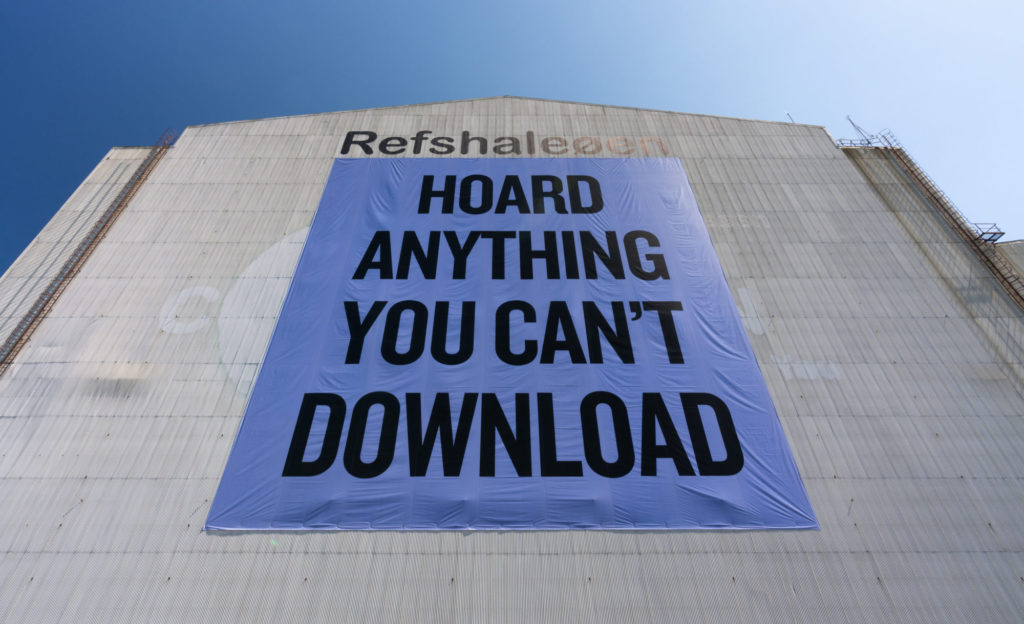Under Open Skies
‘No Justice, No Peace’, ‘I can’t breathe’, ‘Keep a distance’. These words have spread like wildfire globally, testifying to a world marked by change and consternation. COVID-19 has claimed hundreds of thousands of lives, the battle against racism rages in the wake of the killing of George Floyd, a black American, and the #MeToo wave seeks to mitigate violation against women. Humans are on the barricades.
On 25 June, Copenhagen Contemporary opens its doors to the exhibition In Focus: Statements, directly addressing the current global crisis. Copenhagen Contemporary is activated by international world stars indoors and outdoors in the group show In Focus: Statements. Works of art with political texts and messages go beyond the physical framework of CC, sending visitors on a journey of discovery in the former welding hall and outside in the Refshaleøen industrial area.
With focus directed at events happening in the world at the moment: USA’s upcoming presidential election, Brexit, #MeToo, the COVID-19 pandemic, and Black Lives Matter, the exhibition presents artists who, through language, address some of the social issues topping the agenda just now.
LESS POWER LESS
The exhibition is kick-started by a live performance featuring the artist duo Hesselholdt & Mejlvang. Dressed in garb fit for Greek goddesses, they lift up tyres with their bare hands, spelling the words LESS POWER LESS on the slope in front of CC. A realm that was formerly white, feminine, and pure becomes a raw, dirty, masculine scene.
Contemporary linguistic highlights
In Focus: Statements aptly summarises the global crisis experienced by the world at this moment with the COVID-19 pandemic – a crisis denying us social interaction and renegotiating the relationship between citizens and those in power, individuals and groups, and the private and public sphere. While Douglas Coupland encourages us, with a pinch of humour, to stockpile all that cannot be downloaded, Sam Durant visualises, in his work Labyrinth, how isolation affects different groups, for example, prisoners.
In the case of COVID-19, language and rhetoric have played a crucial role in communicating the crisis in the media and public space. New words have emerged while others have taken on new meanings. Several works in the exhibition, therefore, trace the changing meanings of words from they were created until the present. An example of this is Shilpa Gupta’s work from 2008–09 consisting of soaps inscribed with the word Threat – no longer solely associated with debates on ethnicity and identity politics, but also on hygiene and danger of infection. The same is true of Monica Bonvicini’s Hy$teriafrom 2019, a fitting epitaph to the situation facing financial markets since the outbreak of COVID-19.
Many of these works are not recent – but we interpret them in the context of the present. Jenny Holzer’s marble benches with engraved texts – describing the loss of a loved one to AIDS – now brings to mind the privations and deaths brought about by the COVID-19 pandemic. Zoe Leonard’s text I Want a Dyke for President from 1992 is about wanting a president who embodies some of the experiences shared by ordinary people.
The artist Marilyn Minter has created gender political works for decades, subscribing to the struggle of the #MeToo movement to end the suppression of women when Donald Trump’s (in)famous statement ‘Grab them by the pussy’ is placed on an election poster in citation marks. Adrian Piper addresses the right of people to decide on matters affecting their own bodies by formulating statements on a business card for you to take with you and hand out if anyone oversteps your personal boundaries.
In various ways, the works in the exhibition are a reminder that the language we use is not neutral, but plays a part in forming us and our understanding of the world. Language is powerful, daily defining our experience of social inequality, representation of minorities, abuse against women, suppression, racism, climate responsibility, and other big questions of concern to us at present.
The outdoor part of the exhibition is open from 25 June until 30 August whereas the indoor part can be experienced until 30 December.
Gallery name: Copenhagen Contemporary
Address: Refshalevej 173A, Copenhagen
Opening hours: Wed, Fri-Sun 11:00 - 18:00, Thu 11:00 - 21:00
Open: 25.06.2020 - 30.12.2020







